Imagine a homeowner in Oakland, California, who inherits a property that has not been updated in decades. The roof leaks, the kitchen needs a complete overhaul, and the electrical system is outdated. With limited time and no interest in managing costly renovations, the owner decides to sell the house as-is to avoid delays, reduce stress, and secure a straightforward transaction.
Situations like this are increasingly common, especially for those facing job relocations, financial hardship, or inheriting older homes. If you are considering a similar option, this guide explains what an as-is sale means legally and financially, how to price your home, what buyers expect, and how to handle required disclosures. Whether you are aiming for speed or simplicity, this guide offers supportive, practical advice to help you make an informed and confident decision.
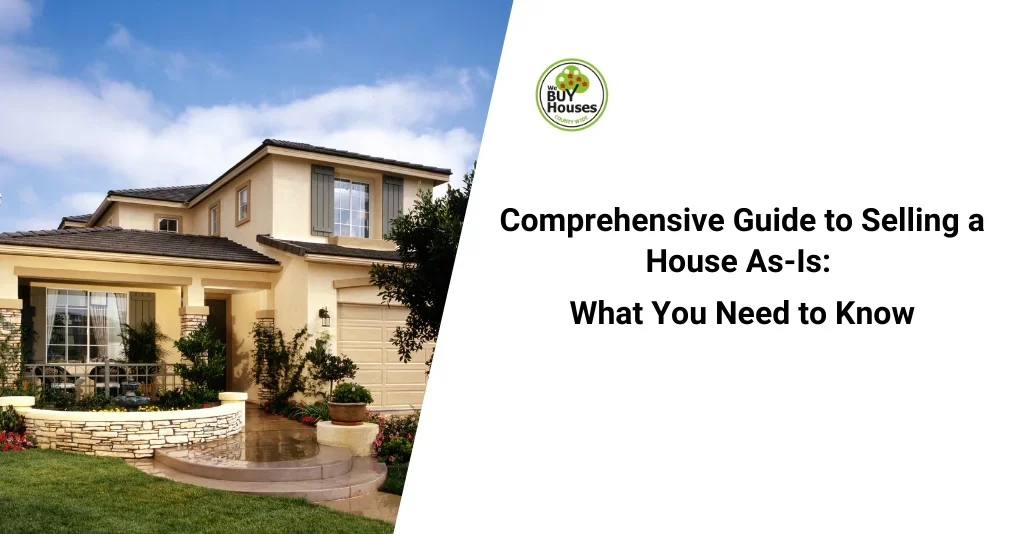
What Does It Mean to Sell a House As-Is?
Selling a house as-is means listing it in its current condition without making repairs or improvements. It tells buyers that what they see is what they get, and the seller will not make improvements or cover repair costs.
However, sellers are still legally required to disclose known problems such as water damage, foundation cracks, or pest infestations. Buyers can also hire inspectors and may use their findings to negotiate the price or walk away. This approach is often chosen for convenience, especially by sellers facing tight timelines or limited budgets, but it demands accurate pricing and may attract a narrower pool of buyers.
What Does Selling a House As-Is Not Mean?
Selling a house as-is does not mean the seller can avoid legal disclosures or that buyers lose their right to inspect the property. It simply means the seller will not complete any repairs before closing. Misunderstanding this can lead to unrealistic expectations or legal issues during the sale process. Here is what the term as-is does not include:
- It does not mean you can hide known issues. Sellers are legally required to disclose problems like mold, roof leaks, or foundation cracks.
- It does not mean buyers cannot inspect the home. Buyers still have the right to hire an inspector and evaluate the property thoroughly.
- It does not mean buyers will accept the price without negotiation. Inspection results can lead to price reductions or canceled offers.
- It does not mean you’re legally protected from post-sale liability. Selling as-is does not remove accountability if the seller conceals major defects.
- Example: A seller lists their home as-is, discloses a sagging floor and previous flooding, and allows the buyer to inspect before agreeing on a final price.
How Does Selling a House As-Is Differ from a Traditional Sale?
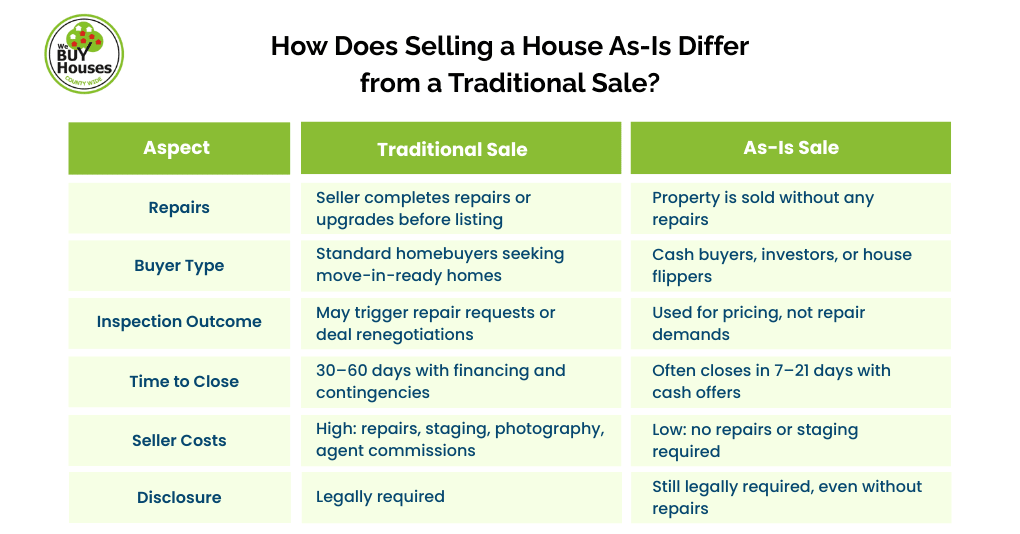
Compared to a traditional sale, selling a house as-is involves fewer upfront costs and a faster timeline, but often leads to a lower sale price and a smaller pool of interested buyers. Traditional sales are structured to attract top-dollar offers through repairs, upgrades, and marketing, while as-is sales prioritize speed and simplicity by selling the property in its current condition. The table below outlines the key differences:
| Aspect | Traditional Sale | As-Is Sale |
| Repairs | Seller completes repairs or upgrades before listing | Property is sold without any repairs |
| Buyer Type | Standard homebuyers seeking move-in-ready homes | Cash buyers, investors, or house flippers |
| Inspection Outcome | May trigger repair requests or deal renegotiations | Used for pricing, not repair demands |
| Time to Close | 30–60 days with financing and contingencies | Often closes in 7–21 days with cash offers |
| Seller Costs | High: repairs, staging, photography, agent commissions | Low: no repairs or staging required |
| Disclosure | Legally required | Still legally required, even without repairs |
Cost of Selling a House As-Is
Selling a house as-is often results in a lower sale price, typically 8% to 20% below market value, depending on the property’s condition and location. While sellers save on repair costs, staging, and time, the discount reflects buyer concerns over potential hidden issues and renovation expenses. The actual financial impact varies, but most sellers trade higher value for speed and convenience, especially when selling to cash buyers or investors.
How Much Do You Lose When Selling a House As-Is?
Most homeowners lose between 8% and 20% of the market value when selling a house as-is, depending on the property’s condition, location, and urgency of sale. For example, a home valued at $600,000 in move-in-ready condition might sell for $480,000 to $552,000 if listed as-is. This price gap reflects the cost of necessary repairs and the uncertainty buyers factor into their offers. Homes with visible damage, deferred maintenance, or outdated systems tend to fall at the lower end of this range.
Why Do Homes Sell for Less When Sold As-Is?
Homes sell for less when listed as-is because buyers factor in repair risks, renovation costs, and uncertainty about the property’s condition. Without guarantees or improvements, buyers lower their offers to protect themselves from unexpected expenses. This perception of risk directly impacts how much buyers are willing to pay.
Here are the main reasons buyers offer less:
- Repair risk: Buyers expect to invest in repairs immediately after purchase.
- Unknown costs: Without seller repairs, buyers assume worst-case scenarios for plumbing, electrical, or structural issues.
- Financing limitations: Lenders may not approve mortgages for homes in poor condition, reducing buyer competition.
- Reduced appeal: Homes that look neglected or outdated often lose visual appeal and attract fewer offers.
- Negotiation leverage: Buyers use the as-is label to justify price reductions or request concessions.
How Do You Price a House As-Is Without Losing Too Much?
The best way to price a house as-is without losing too much is by analyzing comparable as-is sales, factoring in repair costs, and setting a price that appeals to cash buyers and investors. Sellers who take a data-driven approach often reduce losses and attract serious buyers quickly.
Steps to price a house as-is without losing too much are:
- Study recent as-is sales: Look at homes in similar condition that sold in your neighborhood.
- Deduct repair costs: Estimate major repairs like roofing or plumbing and subtract from the market value.
- Price for investors: Leave room for buyer renovations, but avoid underpricing below investor interest.
- Be flexible: Adjust the price based on feedback or market activity to keep the listing competitive.
- Work with experts: Use an agent experienced in distressed property sales or request multiple cash offers.
Who Buys Houses As-Is?
Houses sold as-is are typically purchased by cash buyers, real estate investors, house flippers, and iBuyers who specialize in acquiring properties that need repairs or updates. These buyers are not deterred by cosmetic or structural issues and often seek opportunities to renovate, rent, or resell. Unlike traditional homebuyers, they prioritize fast closings, minimal contingencies, and are prepared to handle the work that comes with the property’s existing condition.
Who Buys Homes As-Is for Cash?
Homes sold as-is for cash are typically purchased by property investment companies, individual investors, or local house-flipping professionals who specialize in fast, no-financing transactions. They purchase properties without needing mortgage approval, allowing them to close in as little as 7 to 14 days. These buyers are often focused on long-term investment, flipping potential, or expanding rental portfolios.
Common types of cash buyers include:
- House flippers: Buy homes in poor condition, renovate, and resell for profit.
- Real estate investment firms: Acquire properties for resale, development, or rental income.
- Buy-and-hold landlords: Look for undervalued homes to convert into income-producing rentals.
- Local investors: Often familiar with neighborhood pricing and market trends.
- Cash-backed iBuyers: Use proprietary models to make quick offers based on property data.
What Type of Buyers Are Most Interested in As-Is Homes?
The most interested buyers for as-is homes are real estate investors, professional house flippers, iBuyers, and even first-time buyers who want to break into the market on a budget. Investors and flippers are drawn to distressed or outdated homes because they see profit in renovating, renting, or reselling them. Unlike traditional homebuyers, they evaluate properties based on potential value after improvements, not the current condition.
For example, a flipper might purchase a home with an old roof and a dated kitchen for $150,000, invest $40,000 in renovations, and resell it for $240,000. Investors may keep similar homes as rentals for steady income, while iBuyers like Opendoor use quick cash offers to acquire properties, streamline sales, and resell with minor updates. In every case, the main motivation is profit, quick turnaround, and control over the renovation process.
What Are the Benefits of Selling a House As-Is?
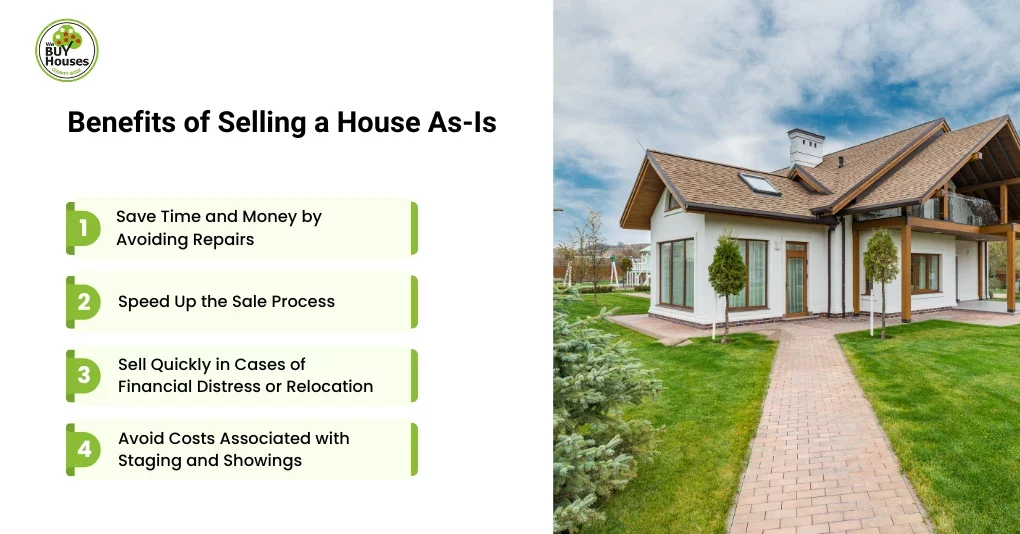
The benefits of selling a house as-is include saving on costly repairs, avoiding the stress of staging and showings, closing the sale faster, and attracting buyers who are prepared to purchase with cash. Instead of spending $10,000 to $20,000 on renovations, sellers can list the property in its current condition and focus on speed and simplicity. This option is especially valuable for homeowners who need to relocate quickly, are managing inherited properties, or want to reduce financial strain without months of preparation.
Save Time and Money by Avoiding Repairs
Selling a house as-is saves homeowners both time and thousands of dollars by eliminating the need for costly renovations. Instead of spending $12,000 on a new roof or $15,000 on a kitchen remodel, sellers can list the property immediately in its current condition. This not only shortens the preparation phase but also allows owners to avoid weeks or months of repair work, contractor scheduling, and construction delays. For many, the ability to move forward quickly without draining savings is the greatest financial and practical benefit of an as-is sale.
Speed Up the Sale Process
Listing a house in as-is condition provides homeowners with the critical advantage of closing weeks faster, which means accessing cash sooner and avoiding months of uncertainty. Traditional sales often stretch 30 to 60 days due to repairs, inspections, and mortgage approvals, while many as-is transactions with cash buyers finish in just 7 to 21 days. By cutting out repair negotiations and financing delays, sellers gain speed and certainty. These two are the most valuable benefits when facing relocation deadlines or urgent financial obligations.
Sell Quickly in Cases of Financial Distress or Relocation
An as-is sale allows homeowners in financial distress or urgent relocation situations to sell quickly without the burden of repairs or extended listing periods. For example, someone facing foreclosure may choose this route to secure a cash offer within two weeks, avoiding damage to their credit. Likewise, a family relocating for a new job can bypass months of renovations and showings, closing the sale in as little as a week or 10 days. By eliminating repair costs and streamlining the process, an as-is sale provides both speed and certainty when time is limited.
Avoid Costs Associated with Staging and Showings
One overlooked advantage of selling a home as-is is eliminating the expense of staging and preparing for constant showings. Professional staging services often cost between $1,500 and $5,000, while additional expenses like deep cleaning, photography, and furniture rentals can push costs even higher. By skipping these steps, sellers save money and avoid the stress of keeping the home in perfect condition for weeks or months. This makes the process simpler and more affordable, especially for those who need to sell quickly.
What Are the Challenges of Selling a House As-Is?
The main challenges of selling a house as-is are accepting a lower sale price, attracting a smaller buyer pool, and facing financing difficulties. Buyers often expect an 8% to 20% discount to cover repair risks, and many traditional buyers avoid homes needing major work. Financing can also be harder to secure, making cash buyers and investors the most likely purchasers.
Lower Sale Price Due to Buyer’s Perceived Risk
As-is homes usually sell for less because buyers see them as risky investments that may hide costly repairs. To protect themselves, buyers typically reduce offers by up to 20% compared to similar move-in ready homes. For example, a $500,000 property in good condition might sell for only $400,000 to $460,000 as-is. This discount reflects not only visible issues like roof damage or outdated systems but also the uncertainty of hidden problems.
Limited Buyer Pool
Homeowners trying to sell a house in as-is condition attract fewer buyers because most traditional homebuyers are looking for move-in-ready houses and prefer to avoid costly repairs. This narrows the field to investors, cash buyers, and flippers who specifically seek out distressed homes. For example, while many families may pass over a property with an outdated roof or damaged plumbing, investors view those same issues as opportunities to increase value through renovation.
Potential Challenges with Financing
Financing can be more difficult for as-is homes because lenders often hesitate to approve mortgages on properties with significant repair needs. Homes with issues like a leaking roof, faulty wiring, or structural damage may not meet appraisal standards, which reduces loan eligibility. As a result, many buyers rely on cash or specialized financing programs such as FHA 203(k) loans, leaving fewer options for traditional borrowers.
How Do You Sell a House As-Is?
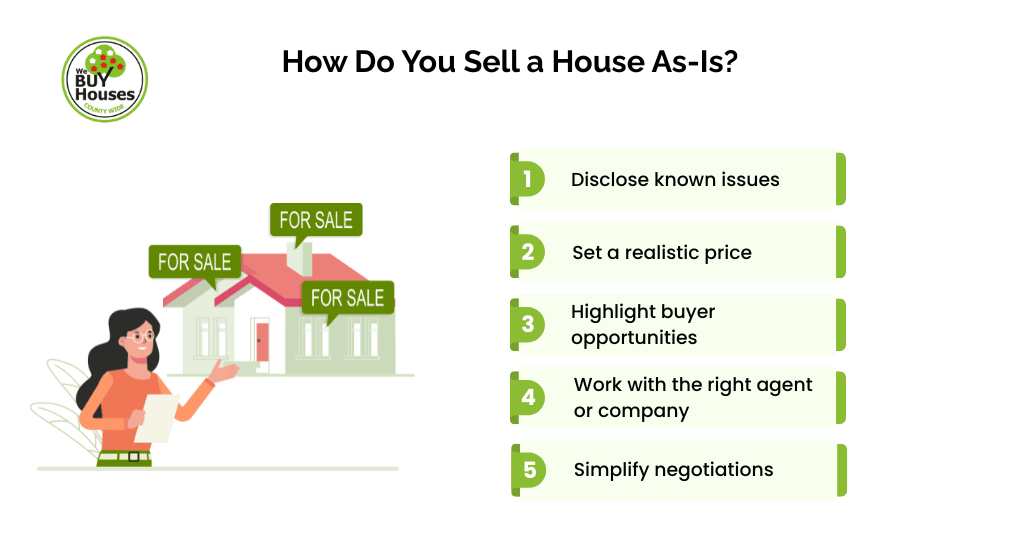
Selling a house as-is involves setting the right price, making legally required disclosures, and marketing the property to buyers who understand its condition. By following a few key steps, homeowners can simplify the process and still secure a fair deal.
Below are the primary steps to sell a house as-is:
- Disclose known issues: Be transparent about problems like leaks, electrical faults, or foundation cracks to avoid legal complications.
- Set a realistic price: Compare similar as-is sales in the area to determine a competitive listing price.
- Highlight buyer opportunities: Market the home as a project for investors, flippers, or cash buyers.
- Work with the right agent or company: Choose a real estate agent experienced with as-is sales or consider direct cash buyers.
- Simplify negotiations: Make it clear upfront that repairs will not be made, which reduces back-and-forth delays.
How to Sell Your House As-Is Effectively?
The most effective way to sell a house as-is is by pricing it realistically, being transparent about its condition, and marketing it to the right buyers. Sellers who approach the process strategically often secure quicker offers and avoid drawn-out negotiations.
Strategies to sell your house as-is effectively:
- Set a competitive price: Use comparable as-is sales in your neighborhood to determine a fair listing value.
- Be upfront about issues: Provide disclosures and, if possible, share an inspection report to build buyer trust.
- Target investor buyers: Highlight the property’s potential for renovation or rental income in your marketing.
- Use the right channels: List on investor-friendly platforms, work with agents experienced in distressed homes, or consider cash buyer companies.
- Focus on speed and certainty: Make it clear that the property is offered as-is, helping attract serious buyers only.
How to Sell a House As-Is Quickly?
The fastest way to sell a house as-is is by working with cash buyers or investors who can close in days instead of months. These buyers are familiar with distressed properties and often skip traditional financing, inspections, or lengthy contingencies, which speeds up the process.
Ways to sell a house as-is quickly include:
- Accept cash offers: Cash buyers and investment firms often close in 7–21 days.
- Work with iBuyers: Companies like Opendoor or Offerpad make near-instant offers based on property data.
- Reduce contingencies: Limit conditions like repairs or seller credits to streamline negotiations.
- Offer flexible terms: Allow buyers to choose fast closing dates to match their investment plans.
- Market directly to investors: Use platforms or networks where flippers and landlords actively search for deals.
Best Practices for Selling a House As-Is
The best practices for selling a house as-is include pricing it realistically, being transparent about known issues, and targeting buyers like investors and cash buyers who expect properties in less-than-perfect condition. Following these steps helps sellers avoid legal complications, attract serious buyers, and secure faster offers.
Best practices for selling a house as-is include:
- Set a fair price based on comparable as-is sales.
- Disclose all known problems such as leaks, mold, or structural issues.
- Market directly to investors, flippers, and iBuyers.
- Allow buyers to conduct inspections to build confidence in the sale.
- Work with an experienced real estate agent or cash-buying company.
- Highlight the property’s potential for renovation or rental income.
- Prepare basic cleanup to improve first impressions without major repairs.
- Be open to cash offers to shorten the closing timeline.
- Keep negotiations simple by making it clear repairs will not be made.
How Do I Market My As-Is Home to Attract the Right Buyers?
The best way to market an as-is home is by targeting cash buyers, investors, and flippers through channels where they actively search for distressed properties. Effective marketing builds trust and highlights the home’s potential rather than its flaws.
Best marketing strategies for as-is homes are:
- List on investor-friendly platforms such as Zillow, Redfin, and Craigslist.
- Highlight the property’s potential for renovation or rental income in the listing description.
- Use clear photos that show both strengths and areas needing work.
- Promote directly to local real estate investors and flipper networks.
- Work with an agent experienced in selling distressed or fixer-upper homes.
- Offer flexible closing terms to attract buyers looking for speed.
- Be transparent about major issues to build credibility and reduce buyer hesitation.
What Repairs Should I Consider Making Before Selling As-Is?
The only repairs worth considering before selling a house as-is are small, inexpensive fixes that improve first impressions without delaying the sale. These low-cost updates can make the property more appealing to investors and buyers without cutting into profits.
Cost-effective repairs to consider before selling a house as-is include:
- Patch holes in walls or ceilings to avoid an unkept appearance.
- Fix leaky faucets or running toilets that suggest neglect.
- Replace broken light fixtures or missing outlet covers.
- Clean carpets or remove stains to improve livability.
- Trim overgrown landscaping to boost curb appeal.
- Repaint scuffed walls with neutral colors for a cleaner look.
- Remove clutter and debris to help buyers see the property’s potential.
How Do I Price My As-Is Home Effectively?
The most effective way to price an as-is home is by using comparable sales, factoring in repair costs, and adjusting for market demand to stay attractive to investors and cash buyers. A clear, competitive price helps avoid long delays and wasted negotiations.
Here are some effective pricing strategies homeowners should opt for as-is home:
- Research recent as-is sales in your neighborhood for accurate benchmarks.
- Subtract estimated repair costs from the home’s market value.
- Price the house slightly below similar move-in ready homes to appeal to buyers.
- Leave room for investor profit while still protecting your equity.
- Consult an agent familiar with distressed properties to refine the price.
- Stay flexible by adjusting based on feedback or low buyer activity.
Selling As-Is vs. Renovating: What’s the Best Option?
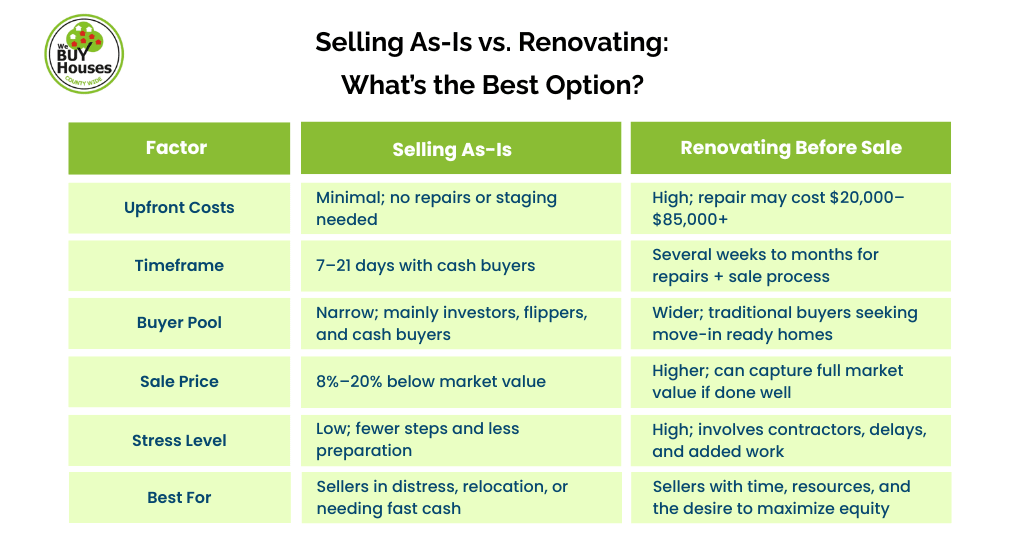
Selling as-is is usually the better option for homeowners who need speed and lower upfront costs, while renovating may be worthwhile if you have the budget, time, and a market where improvements deliver strong returns. Choosing between the two depends on your financial situation, urgency, and the property’s condition.
| Factor | Selling As-Is | Renovating Before Sale |
| Upfront Costs | Minimal; no repairs or staging needed | High; repair may cost $20,000–$85,000+ |
| Timeframe | 7–21 days with cash buyers | Several weeks to months for repairs + sale process |
| Buyer Pool | Narrow; mainly investors, flippers, and cash buyers | Wider; traditional buyers seeking move-in ready homes |
| Sale Price | 8%–20% below market value | Higher; can capture full market value if done well |
| Stress Level | Low; fewer steps and less preparation | High; involves contractors, delays, and added work |
| Best For | Sellers in distress, relocation, or needing fast cash | Sellers with time, resources, and the desire to maximize equity |
Should I Renovate or Sell My House As-Is?
Sellers who want the highest possible sale price should consider renovating, while those who need speed or cannot afford repairs are better off selling as-is. The choice ultimately depends on whether maximizing equity or minimizing stress is the top priority.
| Option | Advantages | Drawbacks |
| Renovate Before Sale | Higher resale value, wider buyer pool, stronger market appeal | Expensive repairs ($20k–$85k+), long timelines, added stress |
| Sell As-Is | Fast closing (7–21 days), no repair costs, simpler process | Lower sale price (8%–20% below market), limited buyer pool |
When Should I Choose to Sell As-Is Instead of Renovating?
Selling as-is is the better choice when you face urgent timelines, limited repair budgets, or inherited properties that require more work than you can manage. In these cases, speed and simplicity outweigh the potential gains from renovating.
Situations where homeowners should consider selling a house as-is instead of renovating are:
- Financial distress: Avoid foreclosure by securing a quick cash sale.
- Limited funds: Sell quickly if repair costs exceed your available budget.
- Severe property damage: Skip costly renovations for homes with fire, flood, or structural issues.
- Job relocation: Sell within weeks to meet a work transfer deadline.
- Inherited homes: Dispose of a property needing major repairs without extra investment.
What Is the Best Way to Sell a House As-Is?
The best way to sell a house as-is is by setting a competitive price, marketing directly to cash buyers or investors, and being upfront about the property’s condition to build buyer trust. This approach ensures a faster sale and reduces complications during negotiations.
Best ways to sell a house as-is include:
- Price competitively using local as-is comps.
- Market directly to investors, flippers, and iBuyers.
- Disclose all known issues to avoid buyer hesitation.
- Offer flexible closing terms to attract cash buyers.
- Work with an agent experienced in distressed properties.
- Consider a direct sale to a residential property investment company.
How Can I Sell My House As-Is for the Best Price?
The best way to sell a house as-is for the highest price is by setting a fair, competitive listing based on comparable sales and presenting the property transparently to attract serious buyers. A realistic price backed by accurate data builds trust and reduces lowball offers.
Following are some tactics that will help you get the best price for your house through the as-is method:
- Use recent as-is sales in your neighborhood as benchmarks.
- Deduct only necessary repair costs when setting the price.
- Highlight renovation potential in the listing description.
- Clean and declutter the property to improve buyer perception.
- Be upfront about known issues to avoid renegotiations.
- Request multiple cash offers to compare buyer interest.
What’s the Fastest Way to Sell a House As-Is?
The fastest way to sell a house as-is is through a cash buyer or iBuyer who can close within 7 to 21 days without waiting for mortgage approvals or repair negotiations. These buyers streamline the process by skipping traditional contingencies, reducing inspection delays, and offering flexible closing dates. For sellers under pressure from relocation or financial distress, this approach provides both speed and certainty.
Legal Requirements for Selling a House As-Is
Selling a house as-is still requires sellers to meet all legal disclosure obligations, including revealing known issues such as roof leaks, mold, pest infestations, or structural damage. While the as-is label means no repairs will be made, it does not remove the duty to provide accurate information through state-specific disclosure forms. Buyers also retain the right to inspect the property, and failure to disclose known ‘latent defects’ can lead to legal liability after the sale.
What Are the Legal Obligations When Selling a House As-Is?
The legal obligations when selling a house as-is require full disclosure of all known issues, even though the seller will not make repairs. Each state has its own rules, but most require sellers to be transparent about major defects to protect buyers and avoid liability.
Common legal obligations property owners should know when selling a house as-is are:
- Disclose structural issues such as foundation cracks or roof damage.
- Report environmental hazards like asbestos, lead paint, or mold.
- Reveal pest infestations or past termite damage.
- Provide details of water damage, leaks, or flooding history.
- Complete state-specific disclosure forms accurately.
- Allow buyers the right to conduct their own inspections.
Do I Need to Disclose Everything When Selling a House As-Is?
Yes, you need to disclose known material defects such as leaks, mold, or structural issues. Failure to do so can lead to legal and financial consequences like damages, contract rescission, or even fraud claims.
Most states require sellers to complete disclosure forms listing all material defects, and buyers may still inspect the property. If crucial information is withheld, courts can order rescission of the sale or award monetary damages to the buyer. In certain cases, sellers have faced civil penalties. For example, one real estate agent was ordered to pay $170,000 for hiding prior water damage, even though an “as-is” clause was used .
What Should Buyers Expect When Buying a House As-Is?
Buyers of as-is homes generally expect a lower purchase price along with the responsibility of making necessary repairs. They approach the transaction knowing the property comes in its current condition, but still want transparency about existing problems.
Typical buyer expectations when buying a house as-is are:
- Discounted price to account for repair costs (up to 20% below market value).
- Full disclosure of known defects such as leaks, mold, or electrical issues.
- Right to inspect before finalizing the purchase.
- Flexibility in negotiations if major problems are uncovered.
- Clear title and legal compliance to avoid future disputes.
Do Buyers Expect to Pay Less for an As-Is House?
Yes, buyers almost always expect to pay less for an as-is house because of the repairs, risks, and uncertainties involved. On average, homes sold as-is close for 8% to 20% below market value, depending on condition and location.
Reasons buyers expect a discount for an as-is house include:
- Repair costs they will need to handle after purchase.
- Perceived risk of hidden or undisclosed issues.
- Financing challenges since some lenders avoid distressed homes.
- Market leverage to negotiate harder against sellers.
- Lower buyer demand compared to move-in-ready homes.
Can You Skip an Inspection When Selling As-Is?
No, you cannot automatically skip an inspection when selling a house as-is, because buyers still have the legal right to request one before closing. While some cash buyers may waive inspections to speed up the process, most traditional buyers expect at least a basic inspection to understand repair needs and risks.
Can I Sell My House As-Is Without an Inspection?
Yes, you can sell your house as-is without ordering a pre-sale inspection yourself, but buyers still retain the right to conduct their own inspection before purchase. In some cases, especially with cash buyers or investors, inspections may be waived to close faster, but skipping one can reduce buyer confidence and limit your pool of offers.
Should I Have an Inspection Before Selling My House As-Is?
Yes, having a pre-sale inspection before selling your house as-is can be beneficial because it identifies issues upfront and builds buyer trust. Sellers who provide inspection reports often avoid last-minute negotiations, set more realistic pricing, and attract serious buyers who appreciate transparency.
